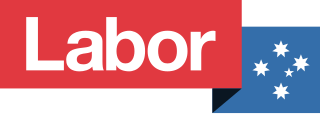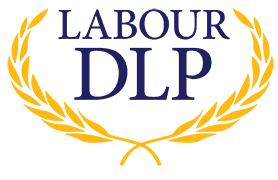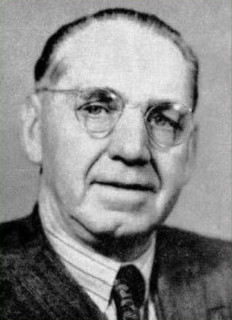
The Australian Labor Party (ALP), also simply known as Labor, is the major centre-left political party in Australia, one of two major parties in Australian politics, along with the centre-right Liberal Party of Australia. The party forms the federal government since being elected in the 2022 election. The ALP is a federal party, with political branches in each state and territory. They are currently in government in Victoria, Queensland, Western Australia, South Australia, the Australian Capital Territory, and the Northern Territory. They are currently in opposition in New South Wales and Tasmania. It is the oldest political party in Australia, being established on 8 May 1901 at Parliament House, Melbourne, the meeting place of the first federal Parliament.

The Democratic Labour Party (DLP), formerly the Democratic Labor Party, is an Australian political party. It broke off from the Australian Labor Party (ALP) as a result of the 1955 ALP split, originally under the name Australian Labor Party (Anti-Communist), and was renamed the Democratic Labor Party in 1957. In 1962, the Queensland Labor Party, a breakaway party of the Queensland branch of the Australian Labor Party, became the Queensland branch of the DLP.

Bartholomew Augustine Santamaria, usually known as B. A. Santamaria, was an Australian Roman Catholic anti-Communist political activist and journalist. He was a guiding influence in the founding of the Democratic Labor Party (DLP).

The Communist Party of Australia (CPA), known as the Australian Communist Party (ACP) from 1944 to 1951, was an Australian political party founded in 1920. The party existed until roughly 1991, with its membership and influence having been in a steady decline since its peak in 1945. Like most communist parties in the west, the party was heavily involved in the labour movement and the trade unions. Its membership, popularity and influence grew significantly during most of the interwar period before reaching its climax in 1945, where the party achieved a membership of slightly above 22,000 members. Although the party did not achieve a federal MP, Fred Paterson was elected to the Parliament of Queensland at the 1944 state election. He won re-election in 1947 before the seat was abolished. The party also held office in over a dozen local government areas across New South Wales and Queensland.

Herbert Vere Evatt, was an Australian politician and judge. He served as a judge of the High Court of Australia from 1930 to 1940, Attorney-General and Minister for External Affairs from 1941 to 1949, and leader of the Australian Labor Party (ALP) and Leader of the Opposition from 1951 to 1960.

Janet Gertrude "Nettie" Palmer was an Australian poet, essayist and Australia's leading literary critic of her day. She corresponded with women writers and collated the Centenary Gift Book which gathered together writing by Victorian women.
The Australian labour movement began in the early 19th century and since the late 19th century has included industrial and political wings. Trade unions in Australia may be organised on the basis of craft unionism, general unionism, or industrial unionism. Almost all unions in Australia are affiliated with the Australian Council of Trade Unions (ACTU), many of which have undergone a significant process of amalgamations, especially in the late 1980s and early 1990s. The leadership and membership of unions hold and have at other times held a wide range of political views, including communist, socialist and right-wing views.
Rowan Cahill is an Australian radical historian and journalist, with a background as a teacher and farmhand, who variously worked for the trade union movement as a rank and file activist, delegate and publicist.
The Workers' Educational Association (WEA), founded in 1903, is the UK's largest voluntary sector provider of adult education and one of Britain's biggest charities. The WEA is a democratic and voluntary adult education movement. It delivers learning throughout England and Scotland. There was a related but independent WEA Cymru covering Wales, though it is now known as Adult Learning Wales since a merger in 2015 with YMCA Wales Community College.

Henry Bournes Higgins KC was an Australian lawyer, politician, and judge. He served on the High Court of Australia from 1906 until his death in 1929, after briefly serving as Attorney-General of Australia in 1904.

Lang Labor was a faction of the Australian Labor Party (ALP) consisting of the supporters of Jack Lang, who served two terms as Premier of New South Wales and was the party's state leader from 1923 to 1939.

James Sinclair Taylor McGowen was an Australian politician. He served as premier of New South Wales from 1910 to 1913, the first member of the Australian Labor Party (ALP) to hold the position, and was a key figure in the party's early history in New South Wales.
The Victorian Socialist Party (VSP) was a socialist political party in the Australian state of Victoria during the early 20th century.

Lawrence Louis Sharkey, commonly known as Lance Sharkey or L. L. Sharkey, was an Australian trade unionist and communist leader. From 1948 to 1965 he served as the secretary-general of Communist Party of Australia (CPA). Sharkey was an orthodox Communist throughout his political career, closely following the prevailing Soviet line in each major turn of policy.
Humphrey Dennis McQueen is an Australian political activist, socialist historian and cultural commentator. He is associated with the development of the Australian New Left. His most iconic work, A New Britannia, gained notoriety for challenging the dominant approach to Australian history developed by the Old Left. He has written books on history, the media, politics and the visual arts.

Percy James Clarey was an Australian trade union leader and politician. He served as president of the Australian Council of Trade Unions (ACTU) from 1943 to 1949 and represented the Australian Labor Party (ALP) in the Victorian Legislative Council (1937−1949) and Australian House of Representatives (1949−1960).

Frederick Carl Katz was an Australian trade unionist and politician. He had a long association with the Australian labour movement, holding senior leadership positions with the Federated Clerks' Union, Federal Miscellaneous Workers' Union, and the Melbourne Trades Hall. He served as a Senator for Victoria from 1947 to 1951, representing the Australian Labor Party (ALP).

Gordon Brown was an Australian politician who served as a Senator for Queensland from 1932 to 1965, representing the Australian Labor Party (ALP). He was President of the Senate from 1943 to 1951.
Patrick Leslie Coleman, Australian politician, was a member of the Victorian Legislative Council for Melbourne West Province representing the Labor Party from October 1943 until March 1955. He was a member of the Catholic Social Studies Movement in Victoria, and was expelled from the ministry and the ALP as part of the Australian Labor Party split of 1955. After his expulsion from the ALP in March 1955, he became, with Bill Barry in the Victorian Legislative Assembly, the parliamentary leader of the Australian Labor Party (Anti-Communist), which was briefly referred to in the media as the Coleman-Barry Labor Party. He was a member of that party only until June 1955.
The Australian Labor Party split of 1955 was a split within the Australian Labor Party along ethnocultural lines and about the position towards communism. Key players in the split were the federal opposition leader H. V. "Doc" Evatt and B. A. Santamaria, the dominant force behind the "Catholic Social Studies Movement" or "the Movement".













